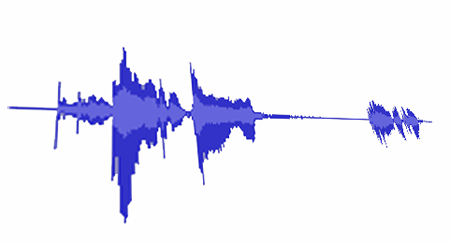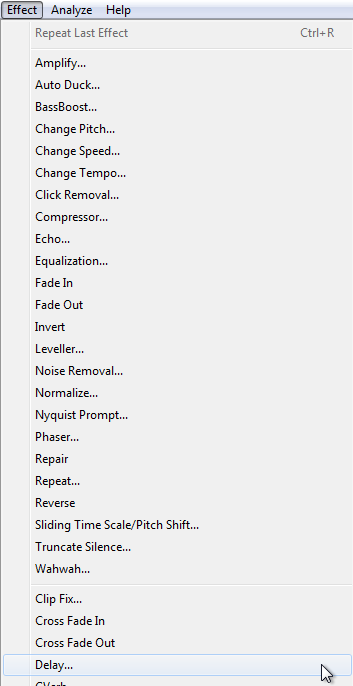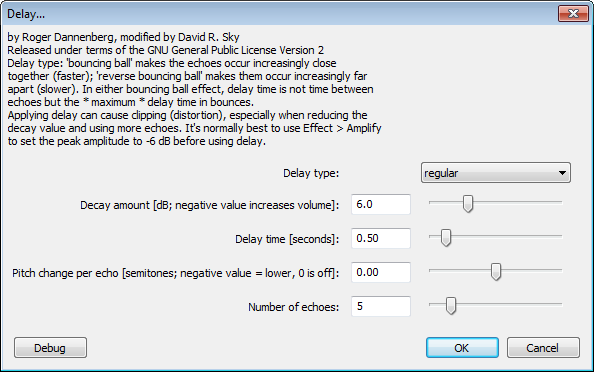
Sometimes a simple echo is, well, just too simple. In this case, the production will call for a more complex echo effect…which brings us to this here post!
In today’s post we walk our readers through the process of using our favorite free, open source audio editing software for PC, aka Audacity to apply multiple echo effects!
How would I use this tutorial? If you have the need for a unique repeating pattern (echo) in your audio production, with fully customizable succession, amplitude and pitch — this is the tutorial for you!
Before starting: Looking for Setup instructions? Our recent Audacity 2.0.0 for Windows Installation Tutorial should do the trick!
For today’s walk-through, we’ll be applying the Delay effect using Audacity 2.0.0 (Windows 7) as run on Parallels; a virtual machine booted in ‘coherence mode’, running on a MacBook Pro.
Step 1: MP3 Download
 Already have your file ready to go on your desktop? Skip to Step 2!
Already have your file ready to go on your desktop? Skip to Step 2!
Before one can edit their AudioAcrobat recording in Audacity, the first step is to make sure that the file resides on the hard drive of the computer on which editing will be performed.
1. Login to your AudioAcrobat account
2. Click Audio (L)
3. Click the Title of the Audio you wish to Download
4. Click Download Audio
Looking for Expanded Steps? Try HERE.
Step 2: Open in Audacity
Now that the file our readers wish to edit is on their computer’s hard drive, they will want to open the file with Audacity. Right-click the file and choose Open With and select Audacity from the list. Don’t see it listed? Open Audacity from Programs folder in the Start menu. Open the software and click File >> Open, selecting the audio to be edited.
Once the file opens in Audacity, our readers will see something like this:
Listen to the above clip!
Step 3: Highlight, Delay, Export
This part is really simple but extremely necessary. Click and drag with the mouse cursor over the area you want to apply the effect, or for those keyboard enthusiasts out there, use Shift + Left / Right arrow keys to make your selection.
For the Delay effect, our readers will want to select Effect >> Delay as seen below:

Immediately after selecting Delay, the following pop-up window will appear:

For today’s example, we’ve left the settings at their defaults, but please feel free to experiment with the values / sliders seen above to fine-tune the effect to your liking.
If you’d like to reference the more technical side of this effect (Decay amount, Delay time, Pitch change per echo, number of echoes), we recommend peeking at the Audacity Manual.
Here’s what our finished version looks like after applying the above settings:
Listen to the above clip!
When satisfied, select File >> Export to save the newly edited version and head over to AudioAcrobat in an internet browser to begin the upload process.
Aside: Notice how the clip has been elongated? Do you also hear the cavernous sound of the echo? This is by design, and confirms that the effect has been successfully applied.
Well that was quick … we’ve already walked through the process of downloading/opening our file, applying the Delay effect using Audacity 2.0.0 for Windows 7 and exporting the file for upload to the Web … and yet it seems as though we had just begun. If you agree, go ahead and click the ‘Previous Post’ link beneath this article to continue the joyride!
Did you get stopped somewhere in the process? Make sure you have LAME correctly setup then shampoo, rinse and repeat the steps listed above. Success will be yours!
Did you find the above process helpful? Were you able to follow-along? Please let us know!
Comment below and connect with us for daily updates!
- Follow AudioAcrobat on Twitter
- Become a fan on Facebook
- Join our group on LinkedIn
- Subscribe to AudioAcrobat RSS
Want to learn more about AudioAcrobat? Go ahead, give it a try yourself by signing up for a 30 day Free Trial or join one of our FREE Training Classes without signing up for squat. Already have an account? Login HERE.
Did you know that AudioAcrobat has a built-in affiliate referral program? Earn 33% commissions, monthly!
Coming up next … #FolowFriday!
